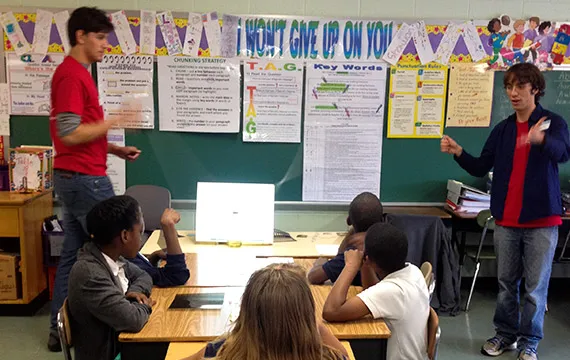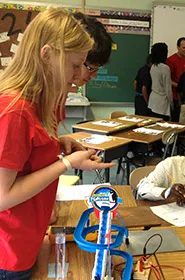Swarthmore Physics Students Engage and Spark Curiosity of Area Schoolchildren

Giggling and wide-eyed, the Toby Farms Elementary students hold hands to conduct electricity. The current zips through the chain of bodies, until one of the students lets go, and the connection is lost.
"An adorable demonstration of teamwork and scientific discovery," says Rachel Flaherman '16, a physics major from San Francisco, Calif.
"Sometimes, doing physics day in and day out, it's easy for me to forget that the subject matter is actually thrilling," she adds. "But it is! The kids remind me of that."
Flaherman is among dozens of Swarthmore's intro-level physics students to bring their science skills into Chester Upland School District classrooms. Initiated by the Physics & Astronomy Department and the Lang Center for Civic & Social Responsibility in 2012, this community outreach effort stimulates curiosity in fun ways.
At the beginning of the semester, Swarthmore students are paired off to develop presentations on phenomena of electricity, magnetism, and optics. A popular one this May featured a plastic stick that glowed and made sounds when two students touched the ends and then each other. Another used toy penguins (the electrons) that climbed stairs (the battery) before going down a slide (the wire) to demonstrate an electric circuit.

Swarthmore students see the program as not just a way to give back to the community, but to stretch themselves intellectually.
"It's about explaining complex concepts in a way that a fifth grader not only understands but is captivated by," says Adam Neat, a physics lecturer at the College who participated in a similar program as an undergraduate and, with Edward Hicks Magill Professor of Mathematics and Natural Sciences Frank Moscatelli, brought it to Swarthmore.
"A little thing like that can be huge in sparking engagement."
The benefits go both ways, though. The Swarthmore students see the program as not just a way to give back to the community but to stretch themselves intellectually.
"It requires thinking about physics at a fundamental level," says Neat, "which can really deepen their understanding."
The program goes into schools that lack the resources needed for students to excel in subjects such as math and science. New Beginnings Family Academy, for example, is a K-12 school with just one science teacher and minimal lab equipment. At Toby Farms, the science teacher switched over from art to fill a hole. Still, the students are engaged and eager to learn.
"They were so excited and enthusiastic and knowledgeable," Flaherman says of the Toby Farms students.
"One student asked me if we study dark matter," adds Neat. "I don't know how many seventh graders there are out there thinking about that."
The hope is that the program will also get the students thinking big on the future.
"Having a bunch of 19- and 20-year-old college students coming in with Swarthmore shirts and smiles on their faces really makes an impression, connecting them and putting a face to this vague idea of college," says Neat. "It's an incredibly positive experience for all involved."



